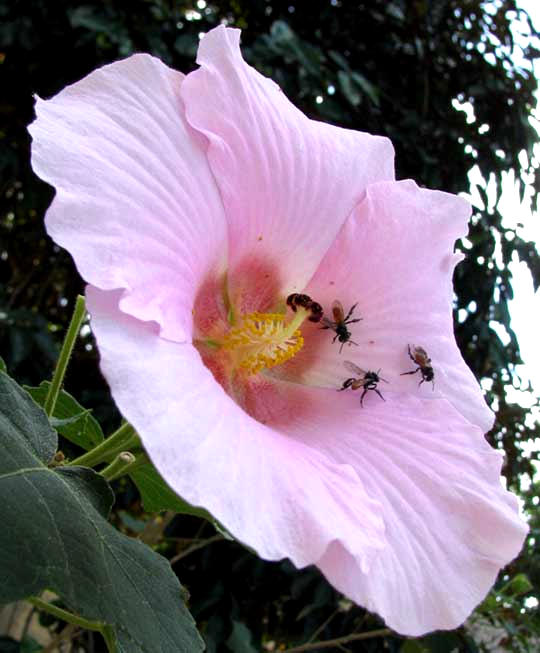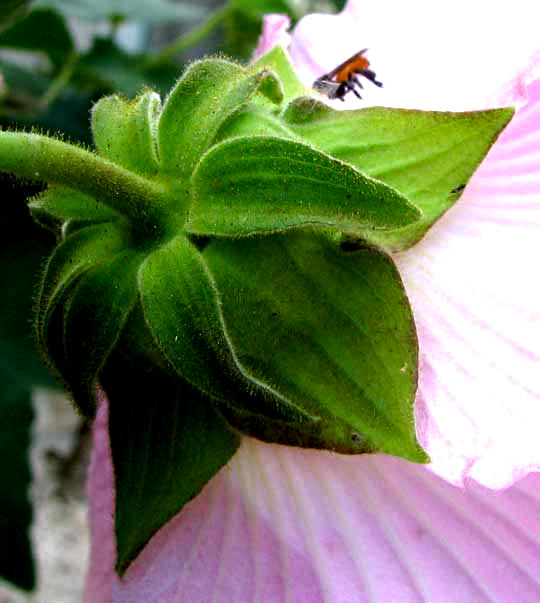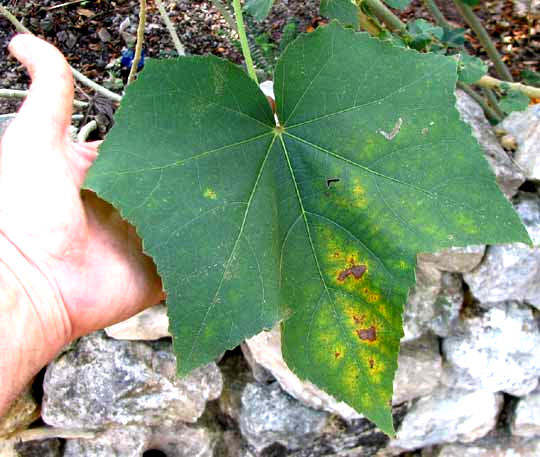Excerpts from Jim Conrad's
Naturalist Newsletter
from the January 9, 2011 Newsletter issued from Hacienda Chichen Resort beside Chichén Itzá Ruins, central Yucatán, MÉXICO; limestone bedrock, elevation ~39m (~128ft), ~N20.676°, ~W88.569°
"CONFEDERATE ROSE"
In Xocimpich, a little Maya town about 10 kms north of Pisté, leaning across one of those dilapidated stone fences so ubiquitous in the Yucatán, there's a tree branch heavy with roundish, shallowly lobed leaves eight inches across (20cm) and with big, pinkish-white flowers four inches abroad. A flower with pollinators is shown below:

I've met this small, shrubby tree in the US Southeast where people call it the Confederate Rose. If you pay any attention at all to flower anatomy, however, you'll see that what's in the picture isn't related to the roses at all, but, rather, with those many stamens uniting at their bases into a cylinder around the pistil's thick, upturned style tipped with five stigmas, it's a hibiscus. It's HIBISCUS MUTABILIS, sometimes also called Cotton Rosemallow, which despite its English names is a native of China.
A close-up of the staminal column surrounding the style with its five, dark, fuzzy stigma heads is below:

There are a jillion kinds of hibiscus. This one is distinguished from other species by it's being a small tree maybe 18 feet high (5.5m) instead of an herbaceous annual, by its exceptionally large flowers, and by each blossom bearing several rather narrow, leaflike " involucral bracts" subtending the five broad, triangular sepals. Bracts and sepals are shown below:

Also it bears unusually large, hairy leaves, shown below:

And then there's this: Its flowers are white in the morning, turn pink during noon and red in the evening of the same day. Clearly the ones in the picture were taken on my weekly morning bike ride around Pisté. Of course people find this color change fascinating. Tinkerers have discovered that white flowers kept in a refrigerator remain white until they are taken out to warm, whereupon they slowly turn pink. Red flowers are reported to remain on plants for several days before they fall off, but all the flowers on the tree I saw were white, so maybe in hot lands red flowers don't hang on so long.
Since this isn't a native plant, the local Maya don't seem to use it for medicinal purposes. However I read that in other cultures the slimy mucilage from its flowers and leaves is used by midwives to facilitate delivery during labor, and that the flowers and leaves themselves are used to treat swellings and skin infections.